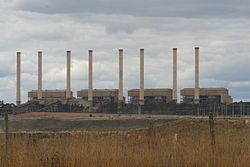
The Victorian Coalition government confirmed this week that it had terminated talks on the previous government’s proposals to shut down two units at the Hazelwood power station in the Latrobe Valley.
The focus on Hazelwood is because it’s the most greenhouse emission intensive plant in the country. This is as result of its age (latest technology in the 1960s is far less efficient than modern plant) and its fuel (brown coal being above 60% moisture). All up, Hazelwood emits around 1.6t CO2 for every MWh produced. This can be compared with about 0.4 for modern gas fired power and 0.8-0.9 for modern coal-fired power. So clearly there are questions about its future in a carbon constrained world. It’s interesting to note that the SECV had planned to shut down Hazelwood by 2005. In private hands it has continued, in a fashion akin to grandfather’s axe, to generate a steady full quarter of Victoria’s energy supply. Of course, the green groups that point out the SECV’s plans to shut it down don’t mention also that the SECV planned to replace it with a larger, more modern and efficient, brown coal fired power station.
The termination of talks has set the environmental NGOs grumbling, but it is sensible policy making for a variety of reasons.
Firstly, it would have been an unprecedented intervention into the energy market. Since the late 1990’s the NEM has seen the bringing on of new plant and the retirement of old, all directed by market forces. Having Victorian Government taxpayers spending money to withdraw plant would have a broad range of distortional impacts. Not least among these is the higher wholesale electricity prices that would result from the removal of 400MW of capacity; this would be especially felt during peak demand periods (summer and winter peaks). Therefore it would cause a scramble among new entrant proponents to replace this plant, increasing costs in this scramble, as opposed to a sensible market based implementation of new capacity. But in the absence of a carbon price and the associated uncertainty of what plant to build to replace it, there is no guarantee that any plant would be built, leading to sustained higher and volatile electricity pricing.
Secondly, closing down greenhouse emission intensive plant is the job of the carbon price, not taxpayer funds. After adding a cost of carbon into the cost of production, Hazelwood will pay the highest cost of carbon per unit of production. Here’s how it works:
For a carbon price of, say, $20/t CO2e, its cost go up by $20/t * 1.6t/MWh = $32/MWh.
Meanwhile, average wholesale energy prices (which Hazelwood earns) increase by the average pool price intensity: $20/t * 1t/MWh = $20/MWh.
So for every $20/t in carbon price, Hazelwood earnings decrease by $12/MWh.
In addition, it may suffer a loss in annual production due to its higher position in the merit order.
The higher the carbon price, the lower the available earnings to cover fixed costs. When there’s insufficient margin to cover fixed costs, then retirement looks like a good option.
There are a range of estimations of the price at which it would be economic for Hazelwood to remove capacity but it starts about $30-50/tCO2e. Once some capacity is removed, CO2 prices may come off (as there is less demand) and power prices go up (as there is less supply), and the margin for the plant remaining in service is improved.
So if retirement is something that would happen anyway under a carbon price, and consumers will be paying the higher costs of energy resulting from the carbon price, why should they ALSO fork out for this intervention?
Thirdly, it’s not clear on what basis it was determined in the first place that a shut down of the units is the lowest cost form of abatement for Hazelwood. There are a range of other options to reduce emissions at these plants, including intermediate operation (as it did prior to interconnection with other states under the National Electricity Market) what I call “seasonal baseloading” (operating at full capacity during summer and winter periods, and then doing maintenance in low demand periods) and co-firing with gas. I imagine there would be other options the owners/operators of the plant will be considering. With a carbon price, the variety of options to plant owners can be assessed by their economic merit and actioned accordingly. It is not a case of governments, or the groups that lobby and pressure them, deciding what the right answer is in advance and then using taxpayer funds to force the outcome.
Ironically, government intervention is the kind of policy described by the Federal Coalition’s Direct Action agenda, that is, government (ie taxpayer) funded purchase of abatement. The central problem with this policy is trying to decide what the “baseline” is against which to award a “credit”. Does it assume that Hazelwood would continue for ever (which is what the owners would suggest) or is there a more realistic projection for its future (which would then result in lower abatement). These kinds of negotiations (involving much bureaucracy and diversion of corporate activity) are avoided when there is a carbon price in place.
So, for now, our taxpayer dollars are saved and the lights stay on. In a carbon constrained world, however, it is likely that Hazelwood will see an early retirement, making room for modern, efficient and low greenhouse-intensive plant.